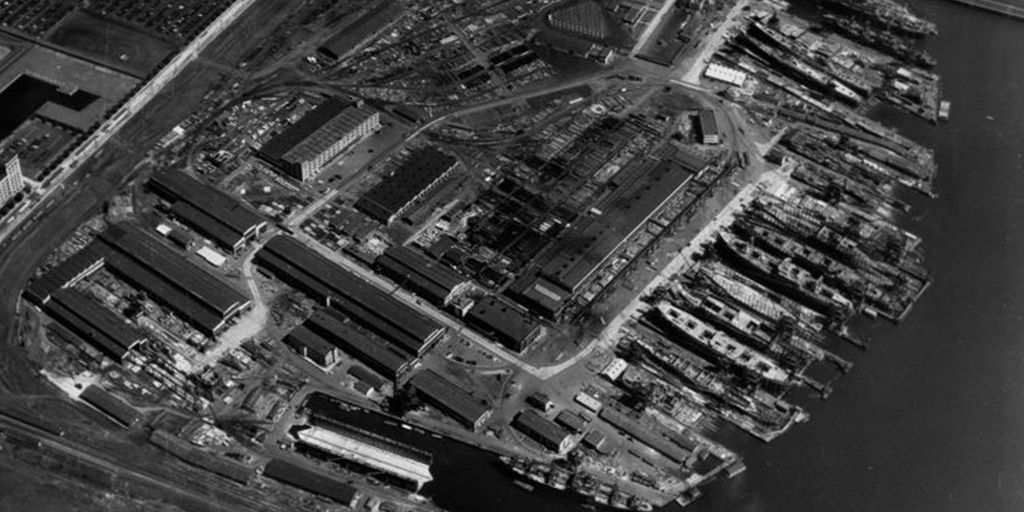From an underground skateboard paradise housed in an abandoned railway line in London, to a highly spiritual residence in Chicago, to a war bunker reimagined as a holiday getaway in The Netherlands, adaptive reuse projects are sweeping the globe. Far from being labeled as “cute” or “trendy” though, the movement toward adaptive reuse has begun to take over new construction in New Jersey—and the most recent projects in the Garden State have started to transform how we, as locals, view the look and scene in the Tri-State area.
In this blog, we’ll become familiar with two of the newest and most fascinating adaptive reuse projects happening in New Jersey.
Kearny Point (Hudson County)
A former shipyard, Kearny Point is located on the banks of the Hackensack River, two miles from the New Jersey Turnpike and right near the Pulaski Skyway. Between World War I and World War II, Kearny Point housed the Federal Shipbuilding & Dry Dock Co. which manufactured a total of 464 ships. To accomplish that, more than 30,000 workers on site met a demanding, record-breaking schedule in which they launched a new ship every five days.
The shipyard was decommissioned after the wars. During the 1960s through the 1970s Kearny Point housed what is now known as the Hugo Neu Corporation, which are still the current owners of the site. Their company began by dismantling ships on site—including massive aircraft carriers and minesweepers—then later moved on to general distribution as local needs changed through the eras.
In its most recent transformation, Kearny Point has begun to redevelop the 130-acre site of 18 properties to offer a potential total of three million square feet of development space. The already-running Building 78 provides office space, a performance and event venue, a bar, and a rooftop lounge with incredible views. Future plans include an elaborate waterfront restoration with a water taxi stop, a marina, a park, and an amphitheater. Additional building restorations may include vertical farming spaces, indoor soccer fields, and a food hall with full liquor licenses.
Redevelopment plans continue into 2020 and beyond, and we can’t wait to see how this site turns out when it’s completed.
The Pointe (Sayreville)
Formerly a highly-contaminated area, The Pointe at Sayreville mega-mall has started to spring up underneath the Garden State Parkway on the 450-acre brownfield site of the old National Lead factory. After spending tens of millions of dollars on environmental reclamation, the large-scale, mixed-use site now boasts a whopping eight million square feet of development potential, including:
- 8 million square feet of leasable space
- A 650,000 square foot marketplace
- 3 miles of waterfront entertainment
- 2 marinas
- 4,000 homes
- A hotel
We must admit: we’re pretty darn impressed at the vision that transformed this contaminated zone into such a bustling commerce hub.
As if The Pointe’s many amenities wouldn’t draw visitors to the site already, the developer, O’Neill Properties Group, is also leveraging their highly visible, centralized location to get additional attention. With LED signs as tall as buildings, 3D imaging capabilities, digital shopping kiosks, and full smartphone interactivity on site, The Pointe is positioning itself as the destination of choice for tech-centric Millennials, ensuring a long, successful future in the years to come.
The Future of Adaptive Reuse
Architects have a special capability to revitalize local areas and improve sustainability in our communities. However, in order to continue our focus on adaptive reuse projects, we’ll need to expand our horizons past the traditional practice of reclaiming old industrial sites or contaminated areas. In addition to these more obvious targets for redevelopment, we can also investigate the feasibility of redevelopment projects for abandoned banks, hospitals, schools, and churches.
But we must also keep our eyes on the future.
For instance, malls are one area that may require increased scrutiny in the years to come. In the ‘90s, malls were a staple of the American landscape with approximately 140 malls built each year until the early 2000s. Since the Recession and the subsequent rise of eCommerce, malls have been closing at rapid rates. Some pundits predict that within the next 15-20 years, “as many as half of American shopping malls will fail.” That means it will be up to the members of the design and construction industry to start reimagining abandoned shopping destinations as community gathering spaces and begin embracing new trends such as pop up stores and food halls.
It’s time for all of us to take up the challenge of rebuilding the world as we imagine it should be. Are you ready? For more information on how to tackle an adaptive reuse project in the state of New Jersey, check out the New Jersey Department of Environment Protection guidelines.
Milrose Consultants has a wealth of experience in transforming existing buildings into new spaces that meet today's building and energy code standards. If you would like assistance meeting code compliance on your project, please contact us today.








